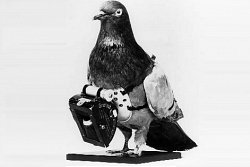Telephones, Telegraphs and Pigeons: why the lines are important. Pros and Cons of communications during World War One.

A battle is won with strategy. Strategy is based on coordination. Coordination is achieved through effective communication.
We are used to thinking about communications as a granted possibility thanks to today’s technological progresses. The advent of telephones has established a revolution in the ways of communication but impossible limitations to prevent this has also existed.
During World War One, the introduction of the telephone and the radio as a tool to keep in touch with soldiers and commanders represented an overestimated innovation. Telephone lines were easy to find and break while radio frequencies were easy to intercept, with eventual information leakage. Therefore, there was a real need to find alternative communication ways.
The telephone was the preferred method of communication due to its synchronous nature which gave the possibility of an immediate share of orders and information. Telegraphs were also highly used, being an effective method of communication over distance, even though they were slower than the telephone. Telegraphs required the sender to write a message, transmit it, and then the receiver to write it down again. Telegraphs and telephones were lighter than radios but required landlines that were unreliable. Soldiers used to trip on the lines and battle fire destroyed them. Therefore, alternative ways to communicate messages were sought.
When communication lines were not working, humans or animals would have to fill the gap.
Soldiers were employed to run through the battlefield and deliver messages. The job was dangerous, the risk was high, and often the messages delivered were inaccurate and out-of-date.
The situation was improved by the use of around 20.000 dogs on the battlefield. Dogs were agile, smaller and faster than humans, capable of avoiding obstacles and moved freely on the ground, becoming harder to spot and stop by the enemies. Dogs were trained to return one-way to their keeper stations and could cover more than 10 miles in 2 hours. However, in that dramatic environment, dogs weren’t just four paw companions they were partners of the soldiers and an important alternative for delivering messages.
Visual communication was also used during the War, with the use of flags, lamps and heliographs. Flags were easy to be spotted by enemies and the messages were easily intercepted, causing soldiers to stop using them after 1916. Lamps were easy to carry and useful to send signals 24 hours a day. However, their outstanding nature used to end up attracting enemy snipers and giving away the position of the messenger. The heliograph was only usable during the day by using a mirror to reflect the sunlight but it was able to cover long distances effectively.
Finally, an alternative way of communication was represented by pigeons. At the beginning of the war there were 60 pigeons and 15 handlers in the war-zone. By 1918 the number of pigeons and handlers increased respectively to 20.000 and 370. The reason behind the choice is that pigeons could fly at an average speed of 80 km per hour and cover distances of over 160 km. The pigeon was trained to get back home and, once it had arrived, it alerted the handler by trigging a wire attached to a bell, ringing it.
Next time you ring a bell think of the pigeon and imagine the message it may have carried.
Written by: Pietro Paolo Frigenti
